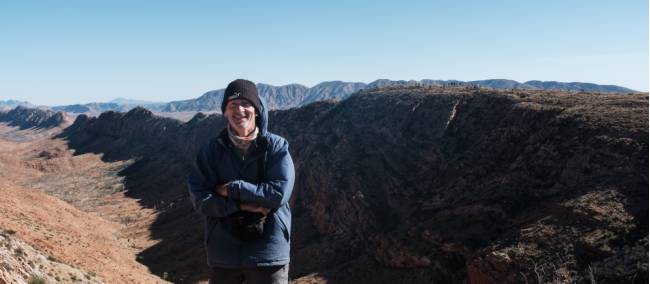
The author at Counts Point on the Larapinta Trail
By Peter Campbell
Why would I want to do this?
The Larapinta is an iconic trail through a beautiful part of Australia, a landscape of ghost gums, spinifex, and red rock gorges unique to Australia. But why do it on my own?
Well, I like my independence. I like to stop and rest whenever I want to, and I don’t want to be restricted to a set itinerary. Although I’m walking solo, there are other people on the trail, so I’m not totally alone.
Without food and water, my pack was about 13–14 kilos. This included all my clothes, tent, camping equipment, first aid kit, and other things such as a personal locator device.
Being an enthusiastic photographer, it’s not unusual for me to stop for a half hour or more to take photos. I can’t do this if I’m with a group. These are the main reasons for going solo.
Now, the question now was, am I fit enough? The Larapinta is a 230-kilometre trail over some very rugged country in central Australia. That wasn’t my main concern. I’ve walked much longer distances (e.g., the Bibbulmun Track, the Camino de Santiago, and many treks in Nepal), but I was younger! I needed to be self-sufficient on the Larapinta, and my pack at times would be 20 kilos or more and this was of some concern to me.
I booked my trip with the World Expeditions group and the logistics of the trip were handled by Australian Walking Holidays in Alice Springs. Their itinerary for solo walkers was 12 days but this was too quick for my liking. However, they were flexible, and it was no trouble to extend my itinerary to 16 days. This enabled me to break a couple of very long days into two. It also meant I would be carrying a maximum of 4 days food at any one time, which would reduce the weight as well.
I started with four days food (included in the cost of the walk), and had food drops placed at Standley Chasm, Ellery Creek and Ormiston Gorge. Of course, water adds weight and at two overnight camps I needed five litres of water. (There are waterholes along the way but not all if them are fit for drinking, so don’t rely on that.)
Without food and water, my pack was about 13–14 kilos. This included all my clothes, tent, camping equipment, first aid kit, and other things such as a personal locator device. (An emergency position indicating radio beacon (EPIRB) is a must have, especially for a solo walker.)
There are permanent campsites along the track. These all have a covered shelter with a sleeping platform, toilets, and water tanks. There are campsite between the permanent camps, but if camping there, you must carry extra water. The Larapinta Trail by John and Monica Chapman is full of information on the trail and what to carry. (Incidentally, I met the author on the trail!)
I carried a Fuji X100F camera, a small fixed-lens camera that I easily carried around my neck the entire trek. The lens is a 35mm equivalent (i.e., a slightly wide angele lens). This may have some limitations, but it is small and light – an idea travel camera.
On this page are a few of my photos which may convince you to walk the trail yourself. If you would like to see more, I published a photo/travel book with called Larapinta Dreaming, which can be bought here. For more about me, please visit Http://rightlightphotography.zenfolio.com.






